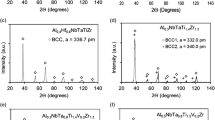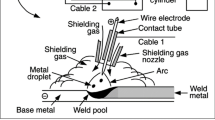Abstract
The late stages of the isothermal proeutectoid ferrite reaction in Fe-C-Mn have been investigated theoretically and experimentally. For the growth of grain-boundary allotriomorphs three temporal regimes must be recognized. In the early regime the grain-size is infinite with respect to the diffusion length of carbon so the growth is parabolic. The middle regime involves the cumulative impingement of the carbon fields from opposite sides of the grains. This regime ends as the carbon activity approaches substantial uniformity through the ferrite and austenite. The final stage involves the extremely slow approach of the manganese towards uniform activity as well. These temporal regimes must be further subdivided into high and low super saturation regions. In the low supersaturation region segregation of manganese must occur at all times, while in the high supersaturation region it must occur significantly only for late times. The growth rates and the diffusion profiles for the third temporal regime have been calculated on a local equilibrium model and compared with the metallographic and microprobe results for alloys within the two regions of supersaturation. The agreement between theory and experiment is in all cases good.
Similar content being viewed by others
References
G. R. Purdy, D. H. Weichert, and J. S. Kirkaldy:Trans. TMS-AIME, 1964, vol. 230, p. 1025.
J. B, Gilmour, G. R. Purdy, and J. S. Kirkaldy:Met. Trans., 1972, vol. 3, p. 1455.
M. Hillert:Inst. of Metals, Monograph No. 33, 1961, p. 231.
H. I. Aaronson, H. A. Domian, and G. M. Pound:Trans. TMS-AIME, 1966, vol. 236, p. 768.
J. B. Gilmour: Ph.D. Thesis, McMaster University, Hamilton, Ontario, September, 1970.
K. R. Kinsman and H. I. Aaronson:Transformation and Hardenability in Steels, Climax Molybdenum, Ann Arbor, 1967.
C. Strawstrom and M. Hillert:J. Iron Steel Inst., 1969, vol. 207, p. 77.
R. A. Tanzilli and R. W. Heckel:Trans. TMS-AIME, 1968, vol. 242, p. 2313.
C. Zener:J. Appl. Phys., 1949, vol. 20, p. 950.
J. S. Kirkaldy and G. R. Purdy:Can. J. Phys., 1962, vol. 40, p. 208.
L. Kaufman, S. V. Radcliffe, and M. Cohen:Decomposition ofAustenite by Diffusional Processes, V. F. Zackay and H. I. Aaronson, eds., p. 342, Interscience, 1962.
C. Wells and R. F. Mehl:AIME Trans., 1941, vol. 145, p. 315.
L. C. Brown and J. S. Kirkaldy:Trans. TMS-AIME, 1964, vol. 236, p. 223.
C. S. Smith:Trans. ASM, 1953, vol. 45, p. 533.
Author information
Authors and Affiliations
Rights and permissions
About this article
Cite this article
Gilmour, J.B., Purdy, G.R. & Kirkaldy, J.S. Partition of manganese during the proeutectoid ferrite transformation in steel. Metall Trans 3, 3213–3222 (1972). https://doi.org/10.1007/BF02661336
Received:
Issue Date:
DOI: https://doi.org/10.1007/BF02661336




